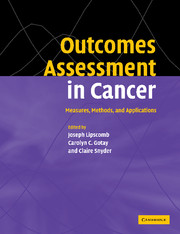Book contents
- Frontmatter
- Contents
- List of contributors
- Acknowledgments
- 1 Introduction to Outcomes Assessment in Cancer
- Health-related quality of life in cancer: general concepts and generic measures
- 2 Definitions and conceptual models of quality of life
- 3 Assessing health status and quality of life of cancer patients: the use of general instruments
- 4 The roles for preference-based measures in support of cancer research and policy
- Assessing health-related quality of life during treatment
- Assessing health-related quality of life across the cancer continuum
- Measuring the experience and needs of cancer patients and caregivers
- Methodological considerations in applications to cancer outcomes research
- Modern psychometric theory in cancer outcomes research
- Assessing the economic impact of cancer
- Research and policy implications
- Invited papers
- Index
- References
2 - Definitions and conceptual models of quality of life
Published online by Cambridge University Press: 18 December 2009
- Frontmatter
- Contents
- List of contributors
- Acknowledgments
- 1 Introduction to Outcomes Assessment in Cancer
- Health-related quality of life in cancer: general concepts and generic measures
- 2 Definitions and conceptual models of quality of life
- 3 Assessing health status and quality of life of cancer patients: the use of general instruments
- 4 The roles for preference-based measures in support of cancer research and policy
- Assessing health-related quality of life during treatment
- Assessing health-related quality of life across the cancer continuum
- Measuring the experience and needs of cancer patients and caregivers
- Methodological considerations in applications to cancer outcomes research
- Modern psychometric theory in cancer outcomes research
- Assessing the economic impact of cancer
- Research and policy implications
- Invited papers
- Index
- References
Summary
Over the past 30 years, quality of life has evolved into a respected construct for evaluating the effectiveness of treatment in health care. The field has grown in methodological rigor and in the sophistication of instrument development. Researchers in oncology have been at the forefront in the evaluation of quality of life, recognizing the need to assess outcomes more broadly than tumor response and length of survival. In 1985, quality of life was identified as a key parameter of efficacy to be used for approval of new anticancer drugs for advanced metastatic disease in the USA. In 1988, the Division of Cancer Treatment (CTEP) of the National Cancer Institute (USA) identified improving quality of life as one of its highest priorities. Quality-of-life endpoints are integral components of cancer clinical trials throughout the world, and are required for all phase III clinical trials by the National Cancer Institute of Canada Clinical Trials Group.
But what is quality of life? The literature contains a bewildering array of characterizations. The term “quality of life” is commonly used to mean health status, physical functioning, symptoms, psychosocial adjustment, well-being, life satisfaction, or happiness. Introducing the term “health-related quality of life” has not solved the problem. Because the terms have meaning in everyday language, they are frequently used without explicit definition. At the heart of the problem is the very nature of the idea of quality of life, which is uniquely personal in its essence.
- Type
- Chapter
- Information
- Outcomes Assessment in CancerMeasures, Methods and Applications, pp. 14 - 30Publisher: Cambridge University PressPrint publication year: 2004
References
- 21
- Cited by



